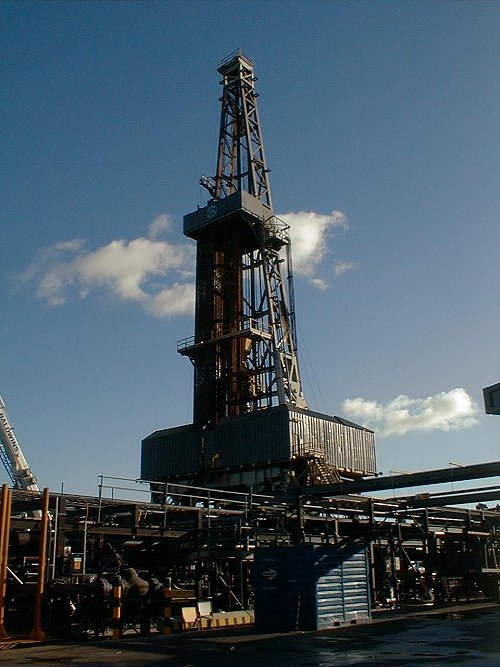| The Wessex basin is the main oil-producing basin of onshore
Britain and Wytch Farm oilfield is the largest onshore oilfield in Western
Europe it produces 110,000 bbl/day, 17.6 x. 106
square cubic feet of gas and 725 tonnes of Liquid Petroleum Gas (LPG) /day
(Holloway et al, 1989).
The Lower Triassic Sherwood Sandstone and the Lower-Middle Jurassic Bridport Sands are the main reservoir rocks for the Wytch Farm oilfield with the Mercia mudstone acting as a seal to the Sherwood Sandstone Group. The Sherwood Sandstone has a thickness of approximately 150m with porosity up to 29% and permeability range from 1.0 - 1500 mD (Bowman et al, 1993). High porosity and permeability within the sandstones at outcrop are due to extensive decalcification and dissolution of framework grains (K-feldspar). |

Drilling Rig at Wytch Farm.
|
At subcrop a characteristic of the Sherwood sandstone is the extremely high porosity and permeability levels in certain narrow bands within the succession. Early cementation by calcite and anhydrite had inhibited compaction. In these horizons it is considered that the anhydrite cement has been dissolved and dissolution of feldspar grains has lead to an increase in porosity (secondary porosity) and permeability. This makes the Sherwood sandstone an excellent reservoir (Penn et al, 1987).
The unit has higher permeability at its base where sand bodies
are thicker and more continuous. The upper layers consist of more poorly connected
sand bodies and mudstones and have a poorer fluid flow. The mudstone layers
within the outcrop are laterally discontinuous so that they do not act as an
efficient seal (Bowman et al, 1993).
![]()
 |
|
Page constructed by M. Wheeler
Copyright © 2000 Mark J Wheeler